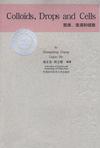胶体、液滴和细胞
2009-6
中国科学技术大学出版社
成正东,何立群 编著
119
大学最重要的功能是向社会输送人才,大学对于一个国家、民族乃至世界的重要性和贡献度,很大程度上是通过毕业生在社会各领域所取得的成就来体现的。 中国科学技术大学建校只有短短的50年,之所以迅速成为享有较高国际声誉的著名大学之一,主要就是因为她培养出了一大批德才兼备的优秀毕业生。他们志向高远、基础扎实、综合素质高、创新能力强,在国内外科技、经济、教育等领域做出了杰出的贡献,为中国科大赢得了“科技英才的摇篮”的美誉。 2008年9月,胡锦涛总书记为中国科大建校五十周年发来贺信,信中称赞说:半个世纪以来,中国科学技术大学依托中国科学院,按照全院办校、所系结合的方针,弘扬红专并进、理实交融的校风,努力推进教学和科研工作的改革创新,为党和国家培养了一大批科技人才,取得了一系列具有世界先进水平的原创性科技成果,为推动我国科教事业发展和社会主义现代化建设做出了重要贡献。 据统计,中国科大迄今已毕业的5万人中,已有42人当选中国科学院和中国工程院院士,是同期(自1963年以来)毕业生中当选院士数最多的高校之一。其中,本科毕业生中平均每1,000人就产生1名院士和。700多名硕士、博士,比例位居全国高校之首。还有众多的中青年才俊成为我国科技、企业、教育等领域的领军人物和骨干。在历年评选的“中国青年五四奖章”获得者中,作为科技界、科技创新型企业界青年才俊代表,科大毕业生已连续多年榜上有名,获奖总人数位居全国高校前列。鲜为人知的是,有数千名优秀毕业生踏上国防战线,为科技强军做出了重要贡献,涌现出20多名科技将军和一大批国防科技中坚。
本书介绍了有关胶体及微流体的一些前沿研究内容,展示了最新的微、纳米水平上的实验和观察方法,有助于读者学习如何分析材料微观结构对宏观物理规律影响的现代研究方法。该书在内容上分为两部分,第一部分是胶体及微流体基本规律;第二部分介绍生物胶体的保存方法。
Preface to the USTC Alumni's SeriesPreface Chapter 1 What Are Colloids? 1.1 Colloids and the atoms: counting the atoms 1.2 Micro-rheology Probe the material properties at microscopic level 1.3 Laser tweezers--Apply external force to nanoparticles 1.4 Colloids 1.4.1 Miniature of the physical world and tangible .models of the atomic world 1.4 2 lnteligent" colloids Chapter 2 Colloids and Phase Transitions 2.1 The hard sphere model 2.1.1 The van der Waals picture of fluids 2.1.2 Close packing of spheres as the principle of crystal structure 2.1 3 Hard sphere model for disorder-order transit'ion 2.2 Model colloidal hard sphere systems 2 2.1 Minimizing van der Waals interaction by refractive index matching 2 2.2 Stabilization 2.2.3 Model Colloidal Hard Spheres 2.3 Properties of hard sphere dispersions 2.3.1 Phase behavior 2.3.2 Equation of state continuing Perrin's measurement at higher concentrations) 2.3.3 Rheology of the fluid and metastable fluid states 2.3.4 Crystal structures 2.3.5 Crystallization kinetics 2.4 Colloids in space 2.4.1 Surprising observations 2.4.2 Crystallization kinetics 2.5 Confocal Imaging: Catch the critical nucleus 2.6 How well do we understand nucleation? 2.7 Applications of colloidal crystals 2.8 Single crystal growth in a temperature gradient Chapter 3 Microfluidics 3.1 Make emulsions drop by drop 3.2 Emulsion crystallization to measure the nucleation rate of colloidal crystallization 3.3 Living cell encapsulation 3.3.1 Colloidosomes 3.3.2 Layer by layer coating 3.3.3 Agarose droplets generation 3.3.4 Yeast cell encapsulation 3 3.5 Tailor the transport property of the microencapsules by LbL coating 3.3.6 Enhancement of the mechanical stability of the microencapsules by hand-particle coating (Colloidosomes) 3.4 Cell manipulation by microfluidicsChapter 4 Biocoiloids 4.1 Biocolloids 4.2 The cell volume change before freezing 4.2.1 The equilibrium volume ofacell 4.2.2 The non-equilibrium volume of a cell 4.3 The change of cell volume during cooling/freezing 4.3 1 Rapid cooling 4.3.2 Slow cooling 4.3.3 Optimal cooling 4.3 4 Modeling the volumetric response of a cell to freezing 4.4 Other mechanisms of cryoinjury……Reference
There are many pioneers in this field who have promoted importantdevelopments to freeze-drying in the last 60 years. Owing to efforts of EarlFlosdorf, Ronald Greaves, and Francois Henalff , the massive production offreeze-dried human plasma was used extensively during World War II whichhad saved many lives. Sir Ernst Boris Chain, the Nobel Laureate forpenicillin, introduced freeze-drying for the preparation of antibiotics andsensitive biochemicals. Charles Merieux opened .wide new area for theindustrial production of sera and vaccines. Recently, some progresses have been made in freeze drying blood cells.In 1993, Sowermimo and Goodrich have firstly reported thathydroxyethyl starch (HES), glucose and their mixtures are new alternative of"bulking" agents of dried red blood cells. With liposomes as a model, Crowe -JH studied effects of HES and glucose on membrane stability, finding thatboth glass formation and depression of Tm in the dry lipids are required. Weinstein et al. investigated the effects of rehydrated erythrocyteafter freeze drying by re-infusing them into the original donors, anddiscovered that the cells survive normally in the circulation with no adverseclinical effects except some slight decrease of deformability. Sowemimo etal. studied on the performance when the rehydrated, lyophilized humanred cells are stored at 4~C. Goodrich Jr et al. studied the possibility oflyophilizing RBC in a manner that maintains normal metabolic and enzymaticfunctions upon rehydration.
